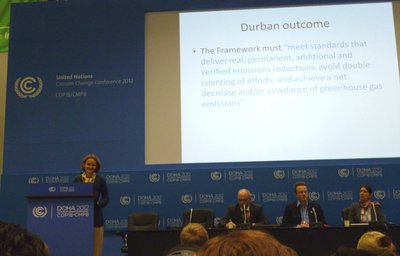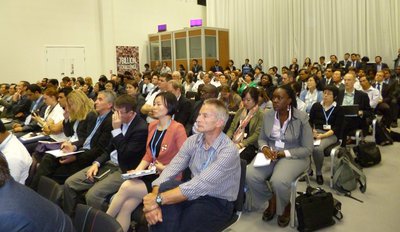5 Feb 2013
Combatting Climate Change: A Proposal for Governing a Market-Based Approach
32 industrialised countries renewed their commitment to the Kyoto Protocol at the annual UN Climate Change Conference (COP18) in December 2012 in Doha, Qatar.
Each Party – ranging from Japan to the United States to Germany – pledged to reduce its greenhouse gas emissions (GEG) during the second commitment period (2013 – 2020) against 1990 levels.
At a side-event around COP 18, Dr. Joëlle de Sépibus from the the World Trade Institute and colleague Wolfgang Sterk presented a paper addressing how an increasing number of countries and regions around the world are implementing emissions trading schemes as a leading strategy to place a price on greenhouse gas emissions (GEG). For example, the European Union Emissions Trading System enables EU countries to purchase or sell units of C02 to help meet their targets. Investing in a solar-power plant in a developing country, rather than in a coal-fired power station, is one way an industrialised country could be rewarded EU Allowance Units (EUA). One EUA represents the right to emit one tonne of C02. Should the industrialised country surpass its annual emission targets, it can sell its ‘additional’ EUAs on the energy market to countries who have exceeded emission caps and who are still looking to reduce their annual carbon count.
In their paper, de Sépibus and Sterk consider the establishment of an overall framework for various mitigation approaches, including opportunities for using markets. This framework would act as a type of “glue” to connect future national and regional mechanisms under the UNFCCC. The idea would be for parties to agree on a minimal number of criteria to keep environmental integrity while easing cross-border trade of carbon credits from different systems (i.e. the EU, the Asia-Pacific region, Japan and California).
After carefully evaluating five design options for such a framework – ranging from decentralised (by region) to centralised governance (by the UNFCCC) – de Sépibus and Sterk recommend sufficient central capacity at the UNFCCC level. A central model that allows for some flexibility, coupled with a robust institutional design, sufficient resources and the possibility to impose sanctions for violations by Parties, would be crucial for ensuring the best possible outcome in achieving global emissions targets by 2020.
Further info
Article: How the UN climate talks can glue together a global carbon market



